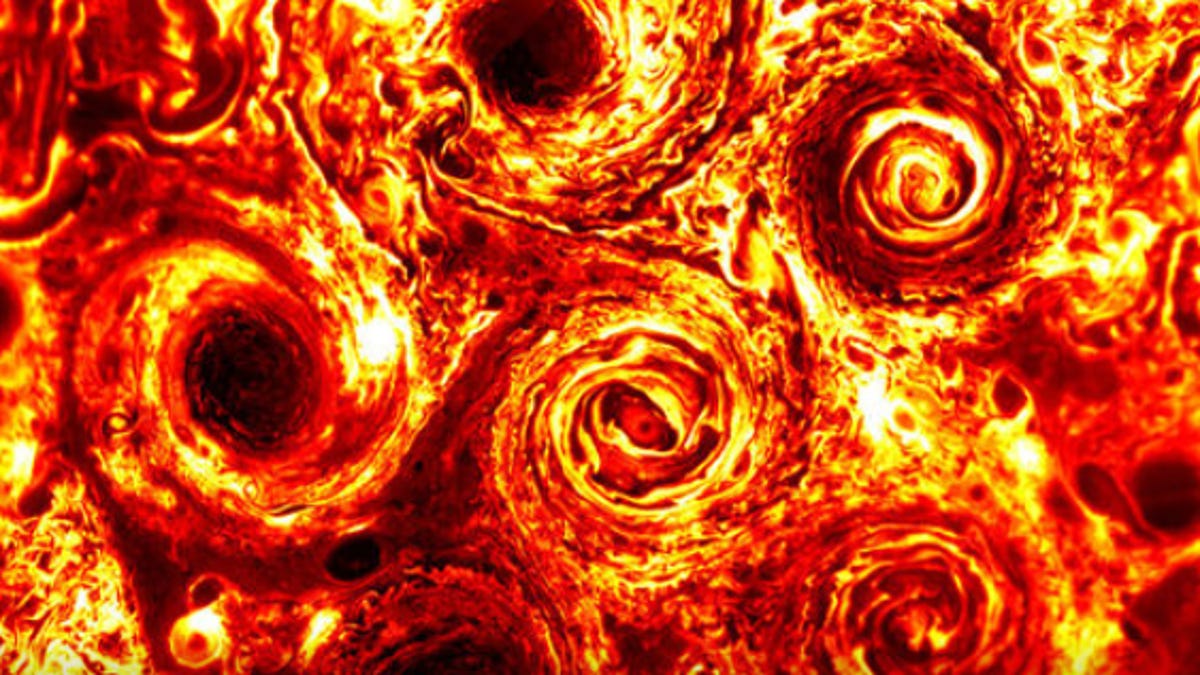NASA's Juno probe discovers Texas-size cyclone on Jupiter
The cyclone joins six others at the planet's south pole.

A group of cyclones on Jupiter have a new addition.
A recent flyby of Jupiter by NASA's Juno spacecraft led to the discovery of a new cyclone, the space agency said Thursday. The flyby, which took place Nov. 3, soared just 2,175 miles above the planet to collect data. The discovery happened while the mission team was working to preserve the solar-powered spacecraft.
"We realized that the orbit was going to carry Juno into Jupiter's shadow, which could have grave consequences because we're solar powered," Scott Bolton, Juno principal investigator from the Southwest Research Institute, said in a release. "No sunlight means no power, so there was real risk we might freeze to death.
"While the team was trying to figure out how to conserve energy and keep our core heated, the engineers came up with a completely new way out of the problem: Jump Jupiter's shadow. It was nothing less than a navigation stroke of genius. Lo and behold, first thing out of the gate on the other side, we make another fundamental discovery."
Upon Juno's first arrival to Jupiter in July 2016, it discovered nine giant cyclones in the north and six in the south that encircled the planet's poles. The data suggested five windstorms were circling around a central storm at the south pole, forming a pentagon around it. It didn't appear the storms were going to stop anytime soon to allow for other cyclones to join, but on Juno's recent flyby -- it's 22nd one -- a new cyclone came to life.
"Data from Juno's Jovian Infrared Auroral Mapper [JIRAM] instrument indicates we went from a pentagon of cyclones surrounding one at the center to a hexagonal arrangement," Alessandro Mura, a Juno co-investigator at the National Institute for Astrophysics in Rome, said in the release.
The new cyclone is about the size of Texas but smaller than the others. Future flyby data could show it getting bigger, Mura said.
Data from JIRAM suggest the new cyclone's wind speeds average 225 mph, which is similar to the velocity in the other cyclones. A camera on the spacecraft also captured visible-light images of the new cyclone. The datasets reveal information about atmospheric processes of Jupiter, Saturn, Uranus and Neptune, NASA says, in addition to giant exoplanets that are being discovered. They also offer an understanding of atmospheric processes of cyclones on Earth.
"These cyclones are new weather phenomena that have not been seen or predicted before," Cheng Li, a Juno scientist from the University of California, Berkeley, said in the release. "Nature is revealing new physics regarding fluid motions and how giant planet atmospheres work. We are beginning to grasp it through observations and computer simulations. Future Juno flybys will help us further refine our understanding by revealing how the cyclones evolve over time."

